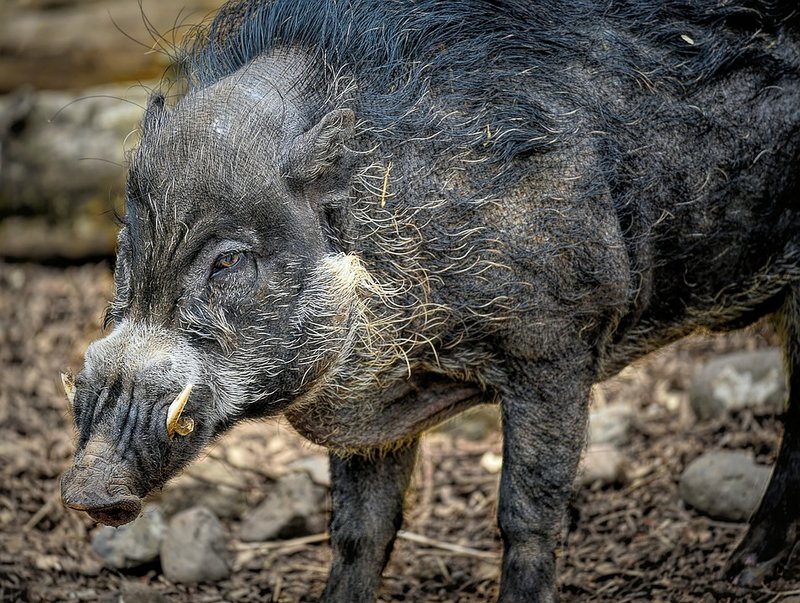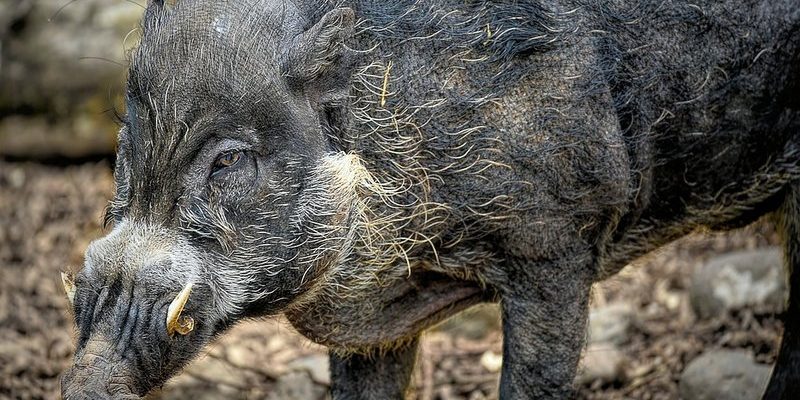
The Visayan Warty Pig is a fascinating, yet endangered species native to the Philippines. Picture a pig that almost seems to wear a crown of warts—each bump not just funky, but a crucial part of its identity! Known scientifically as *Sus cebifrons*, these pigs are characterized by their distinctive facial features and a rugged appearance. But there’s more to this charming creature than meets the eye. They play a significant role in their ecosystem and are a vital part of the cultural heritage in their native regions.
Imagine walking through the lush forests of the Visayan Islands in the Philippines. The air is thick with humidity, and vibrant sounds of nature surround you. Suddenly, you catch a glimpse of a Visayan Warty Pig snuffling through the underbrush. They are shy and elusive, making them a rare sight in the wild. Unfortunately, due to habitat destruction and hunting, their population is dwindling, bringing urgency to conservation efforts worldwide. Let’s dig deeper into their world and learn what makes the Visayan Warty Pig so special.
Physical Characteristics
The Visayan Warty Pig has a rather unique appearance that sets it apart from other pig species. First, their most recognizable feature is, of course, the warts! These are not just for show; they serve multiple purposes, including protection during fights. Adult males usually have three pairs of these prominent warts on their faces, which can look more like rugged badges of honor than unpleasant protrusions.
In terms of size, these pigs are moderately sized. Adult Visayan Warty Pigs typically weigh between 66 to 143 pounds (30 to 65 kg) and reach lengths of about 3 to 5 feet (0.9 to 1.5 meters). Their bodies are stout with short legs, and they have a relatively small head, giving them a compact appearance. Their fur is coarse and can range in color from dark brown to black, which helps them blend into their forest surroundings.
Male Visayan Warty Pigs are larger than females, a common trait in many pig species, and they tend to be more aggressive. Their tusks are quite pronounced, serving both as a tool for foraging and as weapons in territorial disputes. This physicality plays a crucial role in their social structure, as dominance is a key factor in breeding and feeding.
Habitat and Distribution
The Visayan Warty Pig is primarily found on several islands in the central Philippines, specifically on the islands of Negros and Panay. They prefer dense forests and mountainous terrains, where they can forage freely and find shelter. These areas offer them protection from predators and plenty of food sources, including roots, fruits, and small animals.
As humans have expanded their reach, much of the natural habitat of the Visayan Warty Pig has been cleared for agriculture and development. This destruction has not only reduced their living space but has also fragmented populations, making it difficult for these animals to find mates and maintain genetic diversity. Despite these challenges, conservation efforts are underway to protect their remaining habitats and ensure that future generations can enjoy these unique creatures.
Conservation areas are critical for the survival of the Visayan Warty Pig. These protected environments not only help in safeguarding the species but also promote biodiversity within the ecosystem. Education and awareness about their plight are equally important, as the more people understand about the Visayan Warty Pig, the better they can advocate for its survival.
Diet and Feeding Habits
In the wild, the Visayan Warty Pig is an omnivore, which means they eat a variety of foods. Their diet primarily consists of roots, tubers, fruits, and small invertebrates. This variety allows them to adapt to different conditions depending on seasonal changes. Foraging is a significant part of their daily activities, and they use their strong snouts to dig into the ground, which is essential for finding hidden food.
You might wonder how these pigs manage to find enough food in their declining habitats. They are skilled foragers and have keen senses, which help them locate food sources even in thick underbrush. Their adaptability in diet is one of the reasons they have survived for so long, even if their numbers are now dwindling.
Interestingly, their feeding habits also play a role in their ecosystem. As they root around, they aerate the soil, promoting plant growth and helping maintain the health of their forest home. This ecological impact means that the Visayan Warty Pig is vital for maintaining the balance of its habitat, proving that even though they may not be the largest or most famous of animals, they are integral to their environment.
Reproduction and Social Structure
Reproductive habits in the Visayan Warty Pig are quite fascinating. Breeding typically occurs year-round, with females giving birth to litters of about 2 to 6 piglets after a gestation period of approximately 4 months. These piglets are born with a lighter coloration and stripes, which help them camouflage in their natural surroundings, keeping them safe from predators.
Socially, these pigs live in small groups called sounders, typically consisting of a few females and their young. Males are usually solitary outside of breeding season. This social structure allows the sows to work together when raising young, providing protection and teaching piglets essential survival skills.
Hierarchy plays a significant role within sounders, as more dominant females have priority access to food and breeding opportunities. This social dynamic can impact the overall health of the group, as the strongest individuals contribute to the continuation of genetic traits beneficial for survival.
Conservation Status
The current conservation status of the Visayan Warty Pig is concerning. It is listed as Critically Endangered by the IUCN Red List. This classification means that the species is at an extremely high risk of extinction in the wild. Their population has plummeted due to habitat loss and poaching, leading to a dramatic decline in their numbers.
Several organizations are working tirelessly to change the fate of the Visayan Warty Pig. Conservation efforts focus on habitat preservation, breeding programs, and raising public awareness. Zoos and wildlife reserves have also taken part in these efforts by establishing breeding programs to help bolster populations. It’s a race against time to ensure that this unique species does not vanish from our planet.
Engaging local communities is also crucial in conservation efforts. By educating people about the importance of the Visayan Warty Pig and involving them in protection activities, there’s a better chance of success. After all, standing together for wildlife can make a significant difference in the fight against extinction.
Interesting Facts
| Scientific Name: | *Sus cebifrons* |
| Weight: | 66 to 143 pounds (30 to 65 kg) |
| Length: | 3 to 5 feet (0.9 to 1.5 meters) |
| Diet: | Omnivorous |
| Gestation Period: | About 4 months |
| Average Litter Size: | 2 to 6 piglets |
| Conservation Status: | Critically Endangered |
Human-Wildlife Conflict
While the Visayan Warty Pig plays an essential role in its ecosystem, it is not without its challenges in dealing with human encroachment. As agriculture expands into forest areas, these pigs often find themselves in conflict with farmers. They may raid crops in search of food, leading to tension between communities and wildlife. This conflict not only threatens the pigs but also poses challenges for local livelihoods.
Finding solutions to these conflicts is essential for both humans and wildlife. Effective management strategies, such as creating buffer zones between agricultural land and natural habitats, can help reduce instances of crop raiding. Additionally, offering alternative livelihoods to farmers can ease the pressure on both the pigs and the land.
It’s all about balance—finding ways for humans and wildlife to coexist peacefully is crucial. By fostering understanding and collaboration, we can promote the protection of the Visayan Warty Pig while supporting local communities.
The Visayan Warty Pig is not just another animal on the endangered species list; it’s a unique part of our natural heritage. From its distinctive warts to its critical ecological role, this species reminds us of the importance of biodiversity. As we continue to learn more about the Visayan Warty Pig, it becomes clear that protecting them is not just about saving a single species but about preserving the intricate web of life that supports us all.
FAQ
What is the habitat of the Visayan Warty Pig?
The Visayan Warty Pig primarily inhabits the dense forests of the Visayan Islands in the Philippines. They thrive in mountainous terrains and areas with abundant underbrush for foraging and shelter. Unfortunately, habitat destruction due to agriculture and urbanization has significantly reduced their living space, making conservation efforts critical.
Are Visayan Warty Pigs social animals?
Yes, Visayan Warty Pigs are indeed social creatures. They typically live in small groups known as sounders, which usually consist of several females and their young. Males tend to be solitary outside the breeding season. This social structure helps them raise their young and provides protection against predators.
How do Visayan Warty Pigs adapt to their environment?
Visayan Warty Pigs are highly adaptable animals. They are omnivores, feeding on a variety of foods such as fruits, roots, and small invertebrates. This adaptability in diet allows them to thrive in different environmental conditions. Their foraging behavior also plays a crucial role in maintaining the health of their forest habitat.
What do the warts on their face signify?
The warts on the Visayan Warty Pig’s face serve multiple purposes. Primarily, they act as protective features during fights with other males. These warts can help cushion blows and reduce injury. Additionally, they are part of the male’s identity and play a role in attracting mates.
How many Visayan Warty Pigs are left in the wild?
Current estimates suggest that there are only a few hundred Visayan Warty Pigs remaining in the wild. Their status is critically endangered due to habitat loss and hunting pressure. Conservation efforts are vital to ensure their survival and increase their population numbers.
Why is conservation of the Visayan Warty Pig important?
Conserving the Visayan Warty Pig is crucial not only for the survival of the species but also for the health of its ecosystem. These pigs contribute to forest regeneration through their foraging behavior. Protecting them helps maintain biodiversity and the overall balance of their habitat, benefiting many other species as well.
What can people do to help protect Visayan Warty Pigs?
There are several ways individuals can help protect the Visayan Warty Pig. Supporting conservation organizations that focus on habitat preservation and wildlife protection is a great start. Additionally, raising awareness about their plight and the importance of biodiversity can inspire others to participate in conservation efforts.
Can Visayan Warty Pigs be found in captivity?
Yes, Visayan Warty Pigs can be found in some zoos and wildlife reserves. Breeding programs in captivity aim to increase their population and provide a genetic reservoir for future reintroduction into the wild. These programs also help educate the public about the challenges facing this unique species.

